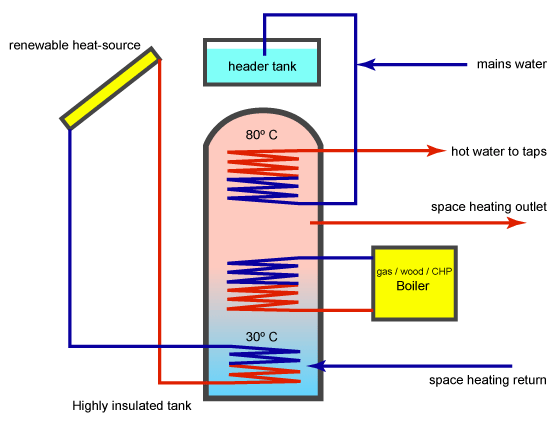Short term storage systems
Combined storage
Combination cylinders are used to store heat for heating and hot water preparation. In most cases, a smaller hot water tank is integrated in the storage tank, which is heated by the surrounding hot water.
Figure 9: Combination storage tank (Source: B.R. Kasper, B. Weyres-Borchert et al., Leitfaden Solarthermische Anlagen, 8th edition, DGS LV Berlin_Hamburg, ISBN 978 3 00 025562 5th edition). Picture right above: https://www.greenspec.co.uk/building-design/thermal-storage/
Solar buffer storage
Buffer storage is particularly useful when fluctuations in supply are to be balanced. Water is used as a storage medium.
The simple buffer tank is used very often, but convective currents form inside the tank, which lead to slight losses and lower temperatures. This convection is avoided in so-called stratified storage tanks. Here, water is stored in layers with different temperatures. The water with the highest temperature is taken at the highest point of the storage tank. However, the use of stratified storage tanks only makes sense if loading and unloading is slow, as otherwise the stratifications would be mixed.
Latent heat storage tank
Latent heat accumulators use the energy that must be supplied to or removed from a substance when it undergoes a phase change (usually from solid to liquid). This technique creates very high energy densities at a certain temperature level. By integrating a latent heat storage tank into the heating system, an efficient use of the energy provided can be achieved, for example by reducing storage losses due to the low storage temperatures. Its use makes sense when the flow temperature reaches about 35 °C, as is the case in energy-efficient buildings. One way of efficiently using the energy provided is to integrate a latent heat storage tank into the heating system. (Leonhardt/Müller 2010)
Sorption storage
Sorption storage systems use the effect that energy can be taken from a substance that absorbs or adsorbs a gas and, in the opposite case, energy must be supplied to achieve desorption.



 Disclaimer: Powered by Erasmus+, ACTeco, ASBN and d.sign Gruber & Partner
Disclaimer: Powered by Erasmus+, ACTeco, ASBN and d.sign Gruber & Partner
You must be logged in to post a comment.